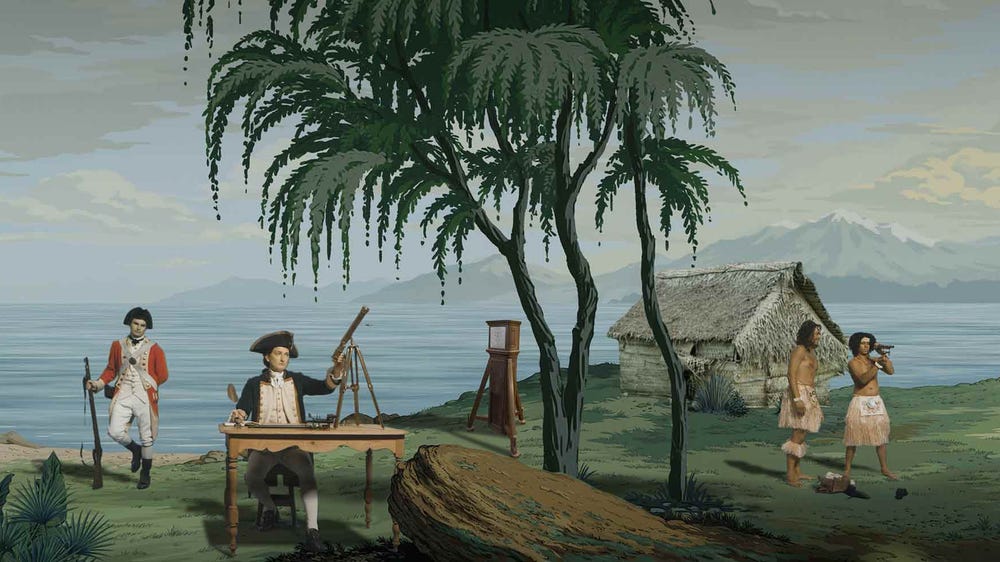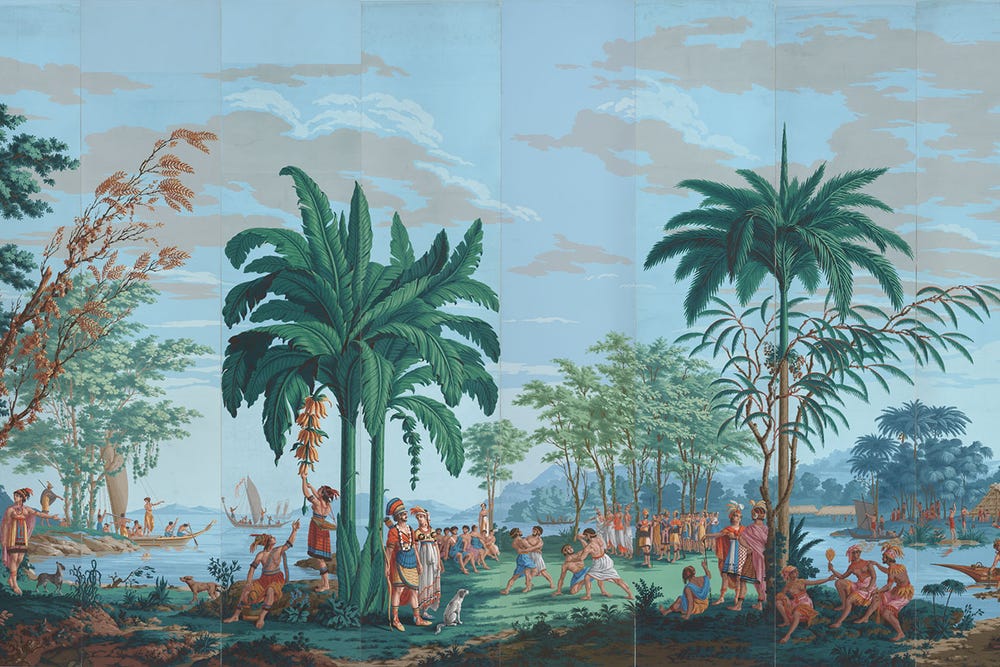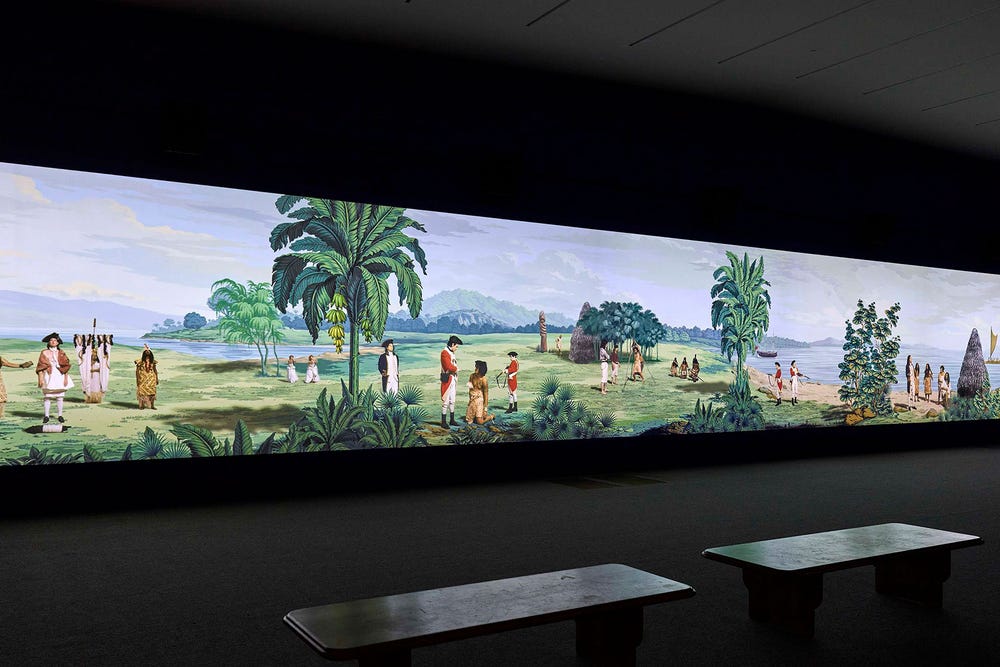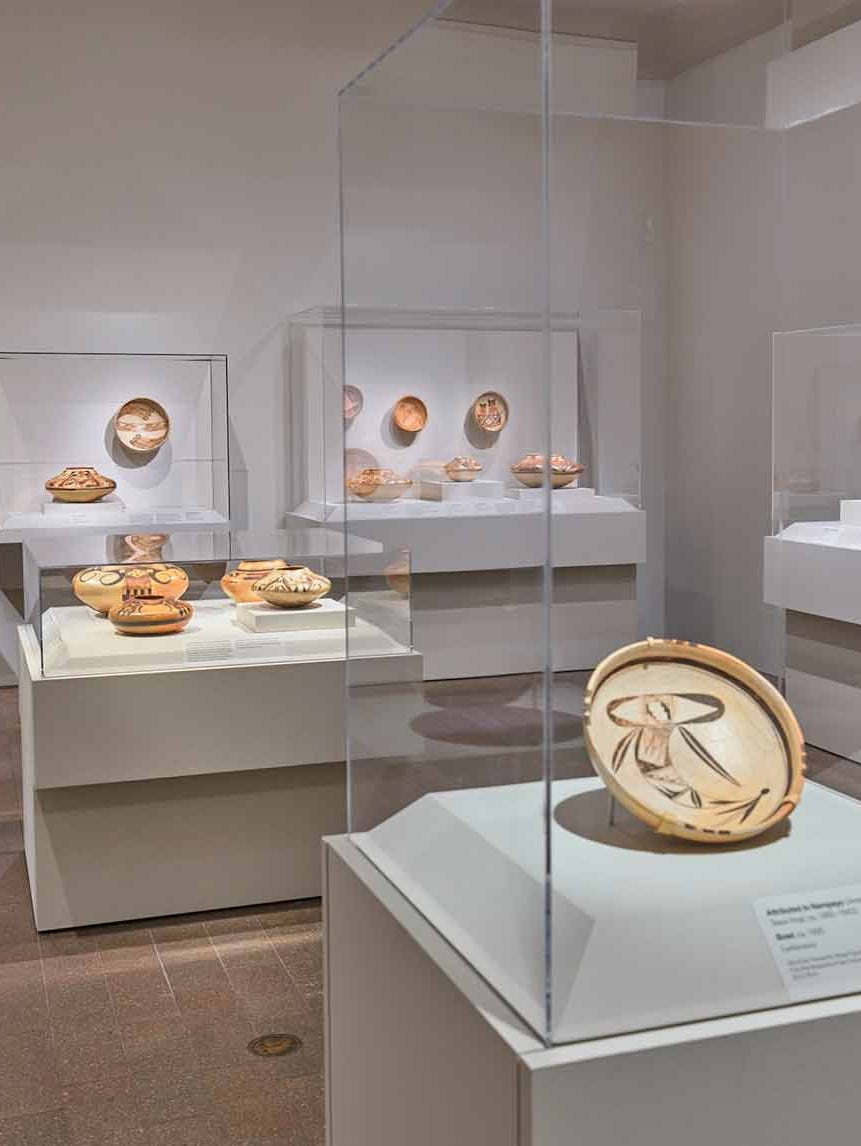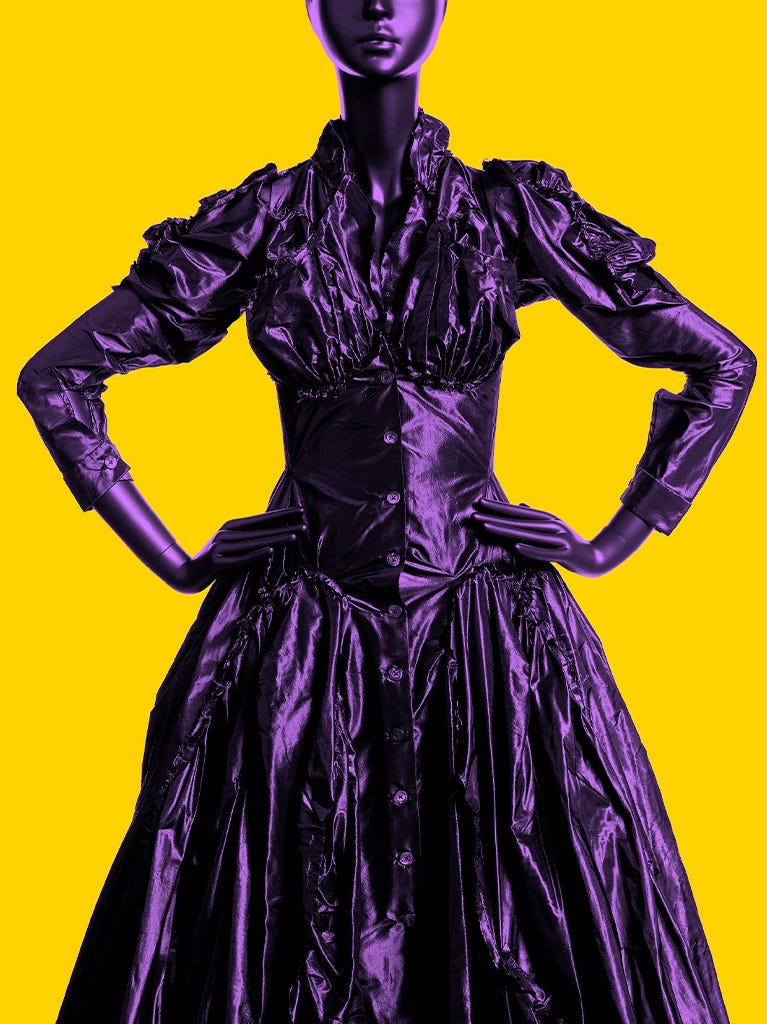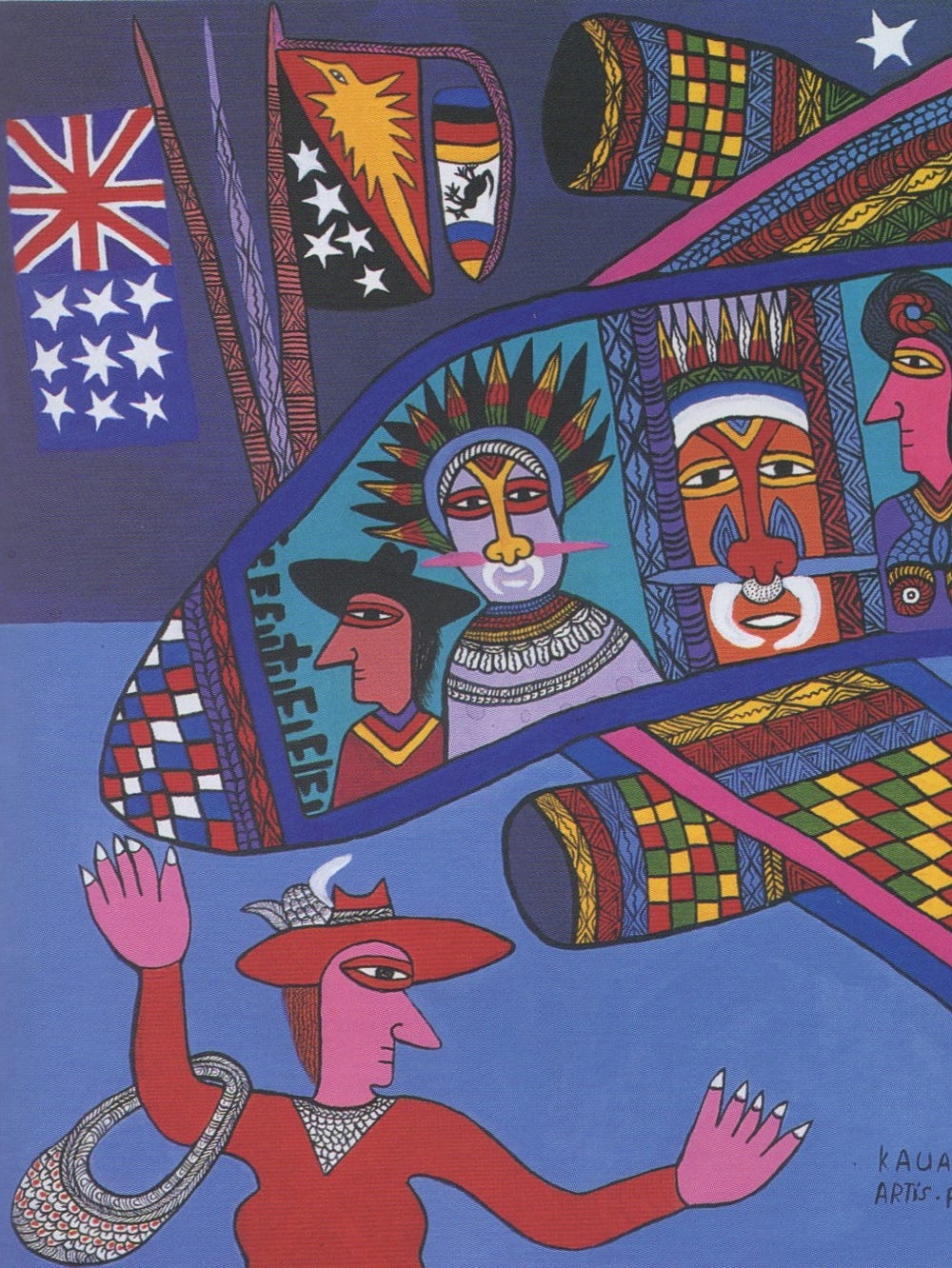Lisa Reihana, in Pursuit of Venus [infected] (detail), 2015–2017. Ultra HD video, color, 7.1 sound, 64 min. Image courtesy of the artist and Artprojects and New Zealand at Venice. With support of Creative New Zealand and NZ at Venice Patrons and Partners
Lisa Reihana: in Pursuit of Venus [infected]
Jump to
Lisa Reihana’s in Pursuit of Venus [infected] — a recent acquisition by the Fine Arts Museums of San Francisco — is exhibited for the first time in the continental United States. The extraordinary 70-foot-long video, animating Reihana’s representation of eighteenth-century views of the Pacific Islands, is presented with the historic French wallpaper on which it is based — Les Sauvages de la Mer Pacifique (Native Peoples of the South Pacific), 1804 – 1805 — plus an eighteenth-century folio with engravings of scenes from Captain James Cook’s travels in the Pacific Ocean, both also from the Museums’ holdings. Reihana reimagines the wallpaper as a vast digital scroll that moves through live-action vignettes placed within an idealized background inspired by the original wallpaper, and asks viewers, “Who tells the story and how do images, past and present, shape our understanding of history?” Reihana has revised the narrative to critique notions about Pacific culture and history that originated with the European voyages of exploration during the eighteenth-century Age of Enlightenment and persist even today.
In depth
Lisa Reihana’s in Pursuit of Venus [infected], a recent acquisition by the Fine Arts Museums of San Francisco, is exhibited for the first time in the continental United States. The experiential multi-channel video animating Reihana’s representation of eighteenth-century views of the Pacific Islands is presented alongside the French scenic wallpaper Les Sauvages de la Mer Pacifique (Native Peoples of the South Pacific), 1804 – 1805, on which it is based. An encounter with the wallpaper in an Australian museum collection led Reihana on a ten-year project to create in Pursuit of Venus [infected], a response to the public fascination with the accounts and art of British naval captain James Cook’s celebrated 1768 – 1780 maritime voyages that brought knowledge of the world’s oceans and their islands’ human inhabitants to London. A 1784 folio with engravings chronicling Cook’s extraordinary travels in the Pacific Ocean beginning in 1776, also from the Museums’ holdings, complements the exhibition.
Cook’s voyages revealed encounters with Pacific people and places unknown in Europe. Exoticized and idealized images, including those that appear on this Neoclassical wallpaper, were derived from the voyage artworks and framed by Humanism, making their way into popular culture. Reihana reimagines the wallpaper as a vast digital scroll 80 feet in length, accompanied by a soundscape that includes dialogue in Pacific languages, moving through live-action vignettes with historical figures and events projected onto the tropical island background of Tahiti found in the wallpaper. Working with collaborators across the Pacific, Reihana has revised the narrative and accompanying images to critique Western notions about Pacific culture and history that originated with Cook’s voyages and persist even today. She asks viewers, “Who tells the history and how do images, past and present, shape our understanding of the story?”
While Pacific Islanders had traversed the vast Pacific Ocean in canoes by the fourteenth century and settled the islands that marked its distant edges, the great sea remained a mysterious uncharted expanse to Europeans until the eighteenth century. Grand maritime voyages of exploration were mounted by England, France, and other countries to pursue scientific discoveries as well as commercial and political aims that emerged during the Age of Enlightenment. The mapping of its islands and boundaries — and the encounters between Pacific Islanders and European mariners — bridged these cultures and changed their historical trajectories. Reihana’s video probes the legacy of this moment in time through its theatrical reprisal.
Another recent acquisition included in the exhibition is a folio containing sixty copper engraved plates of images and two charts. These were published along with the three volumes detailing the official British Admiralty account of Captain Cook’s third global voyage of exploration from 1776 to 1780. While the folio itself is opened to one page, visitors can explore numerous pages of the oversize folio through a digital feature in the gallery. The engravings, many based on the portraits of individuals Cook and his crew met and the events they experienced, were composed to shape public opinion about Pacific culture “in a state of nature” contrasted with European society that was deemed more civilized. There was great excitement on the part of the public to read the accounts of eighteenth-century voyages that reached distant points of the globe — far beyond stops on the Grand Tour of Europe popular at the time — and to see the accompanying images of people and places rendered by the artists onboard. Decorative arts for the home, including wallpaper, adopted the subject of exotic locales.
The Fine Arts Museums’ collection also includes an exceptional example of the wallpaper that inspired Reihana. First exhibited in Paris in 1806, Les Sauvages de la Mer Pacifique (Native Peoples of the Pacific Ocean) also referred to as Les Voyages du Captaine Cook, is believed to be one of the first panoramic wallpapers ever created. Designed by Jean-Gabriel Charvet (1750 – 1829) and manufactured in Mâcon, France, by Joseph Dufour et Cie (1757 – 1827), it was the first successful scenic wallpaper of the nineteenth century, sparking a trend for this large-scale form of luxury decoration for interiors that was also marketed to wealthy middle-class French and American households of the time. The twenty panels embellished with more than 1,000 woodblock prints depict scenes inspired by the three voyages of Captain Cook in more than a dozen different island groups of the Pacific. Charvet based his designs for the wallpaper on drawings and watercolors made by Cook’s shipboard artists, William Hodges (1744 – 1797) and John Webber (1751 – 1793), for scientific purposes. However, the representations are anything but geographically and historically accurate. Dufour explains that they were designed to “please the eye and to excite the imagination.” For example, the designer freely interpreted the Pacific Islanders’ fashions, drawing inspiration from the documentary drawings as well as current fashions of the French Empire period.
Reihana’s provocative video work calls out the fanciful representation of Pacific Islanders in the engravings and wallpaper from the late eighteenth and early nineteenth centuries that shaped enduring stereotypes, and she expands the narrative with new accounts. Her focus on inverting the historic manipulation of images for sociopolitical and economic motivations resonates deeply with contemporary audiences during a time when images are more malleable than ever.
“Kia whakatōmuri te haere whakamua.” (“I walk backwards into the future with my eyes fixed on my past.”) — Māori proverb
In the news
Stories
Sponsors
This exhibition is organized by the Fine Arts Museums of San Francisco. The Fine Arts Museums of San Francisco’s Contemporary Arts Program is made possible by Presenting Sponsors the Lisa & Douglas Goldman Fund and the Donald L. Wyler Trust. Major support is provided by Nion McEvoy and Leslie Berriman and The Paul L. Wattis Foundation. Additional support is provided by Joachim and Nancy Hellman Bechtle, Kate Harbin Clammer and Adam Clammer, Jeffrey N. Dauber and Marc A. Levin, Mr. Joshua Elkes–The Elkes Foundation, Shaari Ergas, Richard and Peggy Greenfield, Katie Hagey & Jill Hagey in memory of their mother, Mary Beth Hagey, Kaitlyn and Mike Krieger, Fred Levin and Nancy Livingston–The Shenson Foundation, Lore Harp McGovern, Jessica and Jason Moment, Katie Schwab Paige and Matt Paige, Rotasa Fund, Chara Schreyer, Mr. and Mrs. Charles R. Schwab, David and Roxanne Soward, Gwynned Vitello, Vance Wall Foundation, Zlot Buell + Associates, and the Contemporary Support Council of the Fine Arts Museums.
